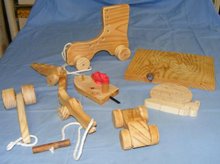Slip, slidin' away...
...on Doc's easy-as soap.
Home made soap is easy and gives you that nice 'I did it' feeling.
They also make nice gifts for those of you who have friends to give them to. ![]()
It is not hard and as long as you have healthy respect for caustic soda (sodium hydroxide) - it burns - you can make soap safely. ![]()
You need a sensible approach to safety: Googles, gloves, free-flowing air, kids and pets at a safe distance in case of spillage etc etc I am frugal and a little slack with a lot of things but not when it comes to safety. ![]()
Other than that, let's party.
Watjaneed
A thermometer or two (one for the pot, one for the jug)
A pot (Stainless steel or enamel) to mix your soap mixture in (not aluminium)
A jug to mix your lye (caustic soda and water)
A wooden spoon or a stick blender (I am lazy - guess what I use) ![]()
Scales for accurate measuring of ingredients
Soap moulds
Soap ingredients - you would be amazed at what you can use. ![]()
An online lye calculator such as here to work out how much lye you need
For moulds, you can make one like I did a few posts ago or you can use anything to put soap into, such as my PVC pipe mould elsewhere on my blog.
For some of my soaps I use latex gloves as moulds - these make my - you guessed it - hand soaps. Great gimmick for markets.
You can even - wait for it - buy moulds from a soap supplier.
Who'd have thunk?
The steps that follow are pretty much what you would use for most soaps.
Use your search engine like this searching tutorial to find more detailed instructions and ingredients for soap-making.
I am just showing you how easy a process it can be. ![]()
For my simple soap I am using an olive oil recipe to make a quick and easy castille soap.
Before we start, get whatever mould(s) you want to use ready.
My recipe
Olive Oil 1058 grams
Water (to mix with lye) 133 grams
Lye 134 grams
Step 1
In a jug add lye to water - be careful because splashes burn. Hence the need for goggles, gloves and a ventilated spot, child/pet free. ![]()
This will bubble, smell and become quite hot. Allow it to cool to around 35 C.
Step 2
Whilst waiting for the lye to cool, select your ingredients according to your recipe and heat in a pot to around 35 C.
Step 3
When the temperature of both the lye and the oil is 35 C, pour the lye (CAREFULLY) into the pot with the oil.
Step 4
With a wooden spoon, stir for ages and ages and ages. Or, with a stick blender, buzz the mixture for a few minutes, mixing the soap thoroughly. ![]()
Step 5
When the soap has reached 'trace' (it thickens and a drop forms a thin trail on top, like a pudding mix) it is then ready to pour into your pre-prepared mould(s). Remember, we got the mould(s) ready before we started.
Many thanks to my lovely assistant, Scarecrow for help folding up the paper in the mould.
Step 6
Once you have poured the soap into the moulds you need to cover/insulate the mould(s) and place them somewhere safe to cool down. This should take up to about 48 hours. With this castille, you may need to gently stir every 12 hours or so but most other soaps can just be allowed to sit.
After 48 hours, the soap can be removed from the mould(s) and cut to size, then placed somewhere to cure (I know, they were not sick in the first place ![]() ) for about four to six weeks.
) for about four to six weeks.
This allows them to solidify properly. Turn over as required - the soaps, not you, to ensure they dry nicely.
Be aware that the soaps will still be a little caustic early on so wear gloves.
Take said soap and wrap in something cute and voila! Frugal, but loveable gift for somebody (or some body).
You can add all sorts of gunk and smelly stuff (essential oils and the like) to the mix at 'trace' to make it smell nice or colour it prettily (?sp) or even add oats, flour, sand and other stuff to cleanse the skin.
I have poured this into my PVC pipe mould that contained a luffa. The soaps are sliced up and it makes a great exfoliate (?word) for babes with delicate skin.
Kinda like sandpapering the bare metal before painting a car, I s'pose. ![]()
As I mentioned, search the net for recipes and do not forget to bookmark your favourites.
For beginners in Australia, here are the translations of some of the ingredients that you can find online or (SHOCK HORROR ![]() ) in a book at your public library:
) in a book at your public library:
All/most of these ingredients can be found at your local supermarket
Lard = Pig fat
Tallow = Solidified Oil (inc rendered beef fat)/Supafry
Palm Oil = Frymaster
Coconut Oil = Copha
The above are usually in the diary fridge section
Olive Oil = Olive Oil (just testing)
Blended Oils = Usually blended vegetable oils
Above probably in the cooking oil section
Castor oil = Castor oil (may be in first aid section of supermarket)
Caustic Soda = sodium hydroxide, sold as drain cleaner in the cleaning section of the supermarket
Scrubbing up 'til next time
Doc ![]()





No comments:
Post a Comment